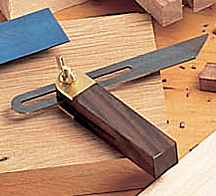
This may be one of those stumpers, but here goes. My grandfather, father, and I have used sliding T-bevels for years. However, in all that time, I’ve never heard what the purpose is for the slanted tip or how it is used. My initial guess would be for the bevel to fold up nicely, but then again, it seems that the slant is fairly consistent from manufacturer to manufacturer. While I’ve found literature dating back to the 1850’s on the T-bevel, discussion revolved around the traditional use of measuring and transferring angles. There was no discussion on that slanted tip. – Phil Rasmussen
Chris Marshall: Phil, that’s a curious question and one I’ve not considered before. My bet is with yours: the slanted tip seats the blade in the handle and keeps it from just slipping through the slot. It makes storage more convenient. Maybe there’s some other purpose for the beveled end close quarter work, perhaps to match an angle that terminates in a tight corner? But your guess is as good as mine. Any other readers want to chime in here?
Tim Inman: Good question. The slanted tip is generally always 45-degrees. I don’t know of any specific purpose or reason for this, but it can be handy. Since 45-degree corners are often laid out with a sliding T-bevel, the 45-degree angle on the tip will help mark out or transfer back to a 90-degree edge on mitered doors, etc. Setting a table saw blade with a T-bevel is easier if the blade length and angle is set so that 45-degree tip makes the whole tool stand up on its own. Other than that, I’ll have to use those three little words Red Green says most guys find so hard to say, “I don’t know….”





